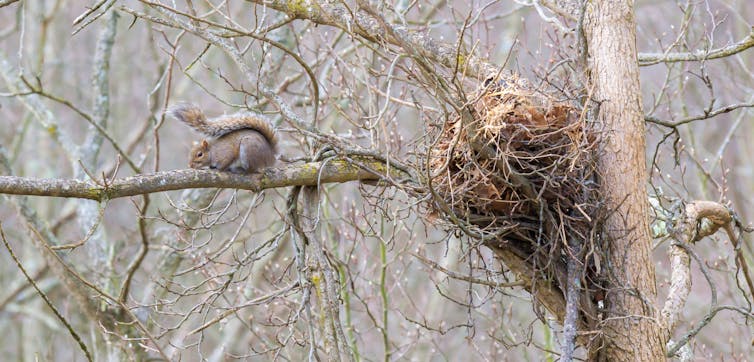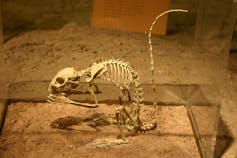
Curious Kids is a series for children of all ages. Have a question you’d like an expert to answer? Send it to CuriousKidsCanada@theconversation.com.
Why do chipmunks live on the ground but squirrels live in trees? — Audrey, 7, Kingston, Ont.
Animals show us that there are many places to make a home. What drives one to nestle in an underground burrow and another to nest in the branches of a tree has a lot to do with two things: family history and how its body works.
Scientists called “evolutionary ecologists” study how living things relate to each other and their environments (ecology) and how these relationships might have influenced what living things look like and how they behave over time (evolution).
The first question to ask is whether or not these chipmunks and squirrels are closely related.
All in the family
Chipmunks and squirrels, which are actually “tree squirrels,” are members of the same family called Sciuridae (sigh-YUR-i-dee), which includes:
- marmots (also called groundhogs or woodchucks)
- flying squirrels
- prairie dogs
- ground squirrels (sometimes nicknamed “gophers,” but true gophers belong to a different family called Geomyidae).
Chipmunks and squirrels are like distant cousins whose most recent common ancestor lived a very long time ago — over 20 million years ago. Distant cousins indeed!
Adaptations help animals be successful
Members of the squirrel family live around the world on every continent except Australia and Antarctica. Different behaviours, shapes and body functions can help increase the chance that they will survive and reproduce in their different habitats. These are called adaptations.

One adaptation that helps animals avoid extreme cold temperatures or low food is hibernation. Underground burrows may have helped the ancestors of chipmunks survive better in their environment.
When chipmunks hibernate, they find a safe place underground to curl up. Then they slow down their heart rate and lower their body temperature by so much that they don’t need to eat.
The ancestors of tree squirrels probably hibernated too, but at some point they lost this superpower. Tree squirrels avoid harsh winters by hanging out in their nests, and digging up the seeds and nuts they buried in the fall to eat.

The oldest known member of Sciuridae (Douglassciurus jeffersoni) looked very similar to what we know today as tree squirrels, with long fingers and toes to help grip branches, and a long bushy tail to help with balance.
Become a squirrel scientist!
With school closed due to the coronavirus, you may be spending a lot more time at home than usual. This is a great opportunity to get to know your local squirrels!
Chipmunks and tree squirrels like to eat seeds (like sunflower seeds), nuts (like walnuts and acorns), and peanuts. Put small dishes of two or more of these snacks in a place where you can watch through a window.
- How many seeds does the animal take in 10 minutes?
- Do they eat the food or do they take food away to store?
- After they visit do they go into burrows or up into a tree?

Bring the food inside at night so you don’t attract other wildlife like skunks or raccoons. Never feed wildlife from your hands, for your safety and the safety of the animal.
You can help scientists see where different animals live! Take photos of your backyard visitors and ask a grown-up to upload them to iNaturalist. If you aren’t sure what species you have, that’s OK! Other experts can help identify your animal from the picture.
Hello, curious kids! Do you have a question you’d like an expert to answer? Ask an adult to send your question to CuriousKidsCanada@theconversation.com. Please tell us your name, age and the city where you live.
And since curiosity has no age limit — adults, let us know what you’re wondering, too. We won’t be able to answer every question, but we will do our best.

